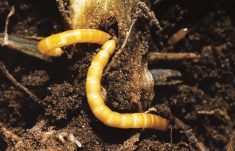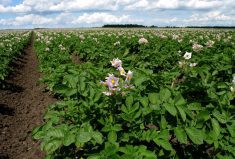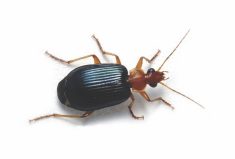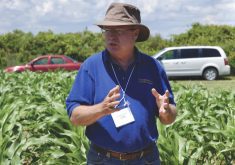Farmers are only hurting themselves if they aren’t giving a helping hand to the natural allies in the fields that can assist them in controlling pests.
Nature not only provides, as the old proverb says. Research proves that it also pays.
In fact, new research even tells us how much it pays. Natural pest suppression is one of the most important services provided by ecosystems, says a new Agriculture and Agri-Food Canada (AAFC) report that cites the work of numerous experts. It pegs the annual value of these beneficial insects at over $400 billion in the U.S. in 1997, and about $5 billion in Canada in 2010.
Not all insects are a scourge to farmers. There are pollinators, of course, and there are also beneficial insects that limit pest populations.
These beneficial insects are of two basic kinds. There are predators, and there are also parasites that come from several insect orders, including beetles, flies, wasps, true bugs and others, according to Lethbridge College’s Jeremy Hummel.
In Saskatchewan alone, a parasitoid that targets wheat midge saved over $248 million in reduced insecticide costs during the 1990s, according to a Saskatoon Research Centre paper.
“The range of beneficial insects is huge,” says the paper’s lead author, Owen Olfert, an invasive insect pests and biodiversity research scientist with the federal Agriculture Department.
The usefulness of these insects in pest control is so significant that they’ll even get imported when necessary. Such is often the case with invasive alien species of pests.
“A lot of our insect invasive alien species came from Europe… and they have a lot fewer natural enemies (here),” says Olfert. If we’re “fortunate,” says Olfert, the beneficials will hitch a ride and arrive at the same time as the invading pest. In those cases, the job of research is to figure out how best to grow the populations of beneficials, so they can do the best job possible.
Read Also

Agronomists share tips for evaluating new crop products and tech: Pt. 3
With new products, new production practices and new technology converging on the agriculture industry at a frenetic pace in recent…
“If there are none that show up and the pest has become a major issue,” Olfert says, “we then have an option to work with our European colleagues to try and find a parasitoid that is very specific to this pest species.” If they find such a species, then the researchers need to file an application to see if they can get permission to introduce it for control.
In the landscape
For the beneficials already here, modern agriculture hasn’t made things easy.
Simplified cropping systems and the development of intensive agriculture have been accompanied by the steady loss of natural habitats, says the AAFC report entitled Agricultural Practices that Promote Crop Pest Suppression by Natural Predators.
Then, a vicious circle takes over, the weakened natural defences of the ag ecosystem leads to the greater use of chemicals to combat rising pest, weed and disease infestations.
“In soybeans, American studies have shown that simplification of the agricultural landscape has resulted in a 24 per cent reduction in the control of the soybean aphid by its natural enemies,” the report notes.
More complex landscapes that contain a greater amount of semi-natural habitat (such as forests, hedgerows, field margins, fallows and meadows) are associated with more abundant and diverse natural enemies, the report adds. They generally contain more beneficial than harmful organisms and provide beneficial insects with not only alternative prey and plant resources, but overwintering shelter as well.
According to the AAFC report, 90 per cent of beneficial insect species need a non-crop environment at least once in their life cycle. By contrast, only half of the pest species require such non-crop hosts or habitat.
There are management practices that can optimize natural enemy activity. Establishing or preserving buffer zones such as field margin strips, hedgerows, beetle banks, conservation strips and windbreaks can help enhance the amount of pest suppression provided by beneficials, the report says.
“There’s this whole group of parasitoids which for the most part are wasps and flies that will lay their eggs in or on another insect, and then the juveniles of those parasitoids will work on consuming and destroying that other insect,” says Hummel, who teaches plant and soil sciences. “The adults of most of those parasitoids are fluid feeders, and for the most part are feeding on nectar and naturally occurring fluid sources. So having that diversified landscape where you’ve got some flowering plants and ditches can promote those beneficials that require that alternate food source for a different point in time of their life cycle.”
Hummel also notes many farmers who put in shelterbelts do so for wind erosion control, but then also get the added benefit of being habitat for beneficial insects.
“Depending on what kind of shelterbelt you’re putting in, it might just be an overwintering habitat for beneficials. If it’s some sort of flowering species, it might also be a nectar source for these beneficials,” Hummel says.
In southern Alberta, farmers tend not to put shelterbelts through fields because they’ll interrupt centre pivot irrigation, but some growers are situating shelterbelts along the edges of their fields.
“It still has some effect in terms of wind erosion control and then secondarily beneficial organism habitat,” Hummel says.
The impact of spraying
Too often, beneficials can get sideswiped by spraying operations. The AAFC report cites research that proves many parasites of canola pests are directly impacted by pesticide treatments during flowering, which is when many insects are especially active.
“For the most part, if the beneficials are present at the time an insecticide is applied, they’re likely to suffer the same fate as the pest species,” says Olfert.
Hummel thinks farmers are gaining awareness of the importance of beneficials and are doing an important job of chemical management.
“While there is still some collateral damage to beneficial insects, there is an increasing awareness that they’re important and they have a role to play, and therefore a consciousness of trying to minimize that damage that happens to beneficials,” Hummel says.
Hummel says farmers can promote beneficial insects with fair management of their agricultural chemicals, taking into account proper timing and chemical selection.
“If we’re using it at an inappropriate time, then we are unnecessarily impacting the beneficials,” says Hummel, adding application should only occur when the pest insect has reached an economic threshold level, meaning there is the imminent risk of economic harm to the crop.
“That’s because if we’re using an insecticide before that point, then first of all, we aren’t offsetting the cost of the insecticide, so economically speaking it doesn’t make sense for the crop producer. But then it has an impact on beneficial insects,” Olfert says. He also stresses farmers also need to determine the chemical that will not only do the job but also have the least environmental impact.
Timing in the case of wheat midge can be tricky. There’s a very narrow window just prior to flowering when the wheat plant is susceptible to egg laying.
“That’s a very narrow period of time, so we’ve stressed to spray only during that time if there is a sufficient economic threshold to warrant the control,” says Olfert. “If they’re spraying too early or spraying after that period of time, first of all, they’re wasting their money, and second, they’re doing more damage to the biocontrol agents than the actual population of pests.”
How to determine economic threshold is changing as a new model emerges that takes beneficials into account, says Erl Svendsen, AAFC senior environment resource specialist.
“Given a certain number of pests and natural enemies, that economic threshold shifts dramatically. The idea is if you have enough natural enemies, you may not have to go out and spray,” says Svendsen.
New field guide
Another resource is the updated illustrated field guide of crop and forage pests, last produced around 1989.
“In those 25 years, we’ve had quite a number of new alien invasive species show up,” says Olfert, who originally started this project. “But on the other hand, anything that was native is still there and will have to be reincorporated into this new addition.”
Svendsen is the other contributor and notes the previous guide was far more general than the one he and Olfert have worked on.
“That one covered everything from soups to nuts,” Svendsen says. “It covered not just crop pests but animal pests and household pests, food pests, horticultural pests. This one is focused on those pests that only affect crops and forages in Western Canada.”
The previous guide also sported a fairly small single picture of each insect, whereas the updated one attempts to capture the major important life stages of pests and the damage they can inflict.
“If you’re going out into a field and you see a particular pattern, it narrows down what pest could be impacting your crop,” says Svendsen.
The new guide will also link the beneficials, economic thresholds and other data. “We don’t know all the answers for those questions, but that information as much as possible has been included in this new manual. In the old version, there was no economic threshold, or management or conservation advice,” Svendsen says.
The guide is being released this spring, with additional copies available for this summer. It will also be available online as a downloadable pdf that will offer a number of features, including hyperlinking to other sources of information.
This article first appeared as “Boost your beneficials” in the April 2015 issue of Country Guide

















